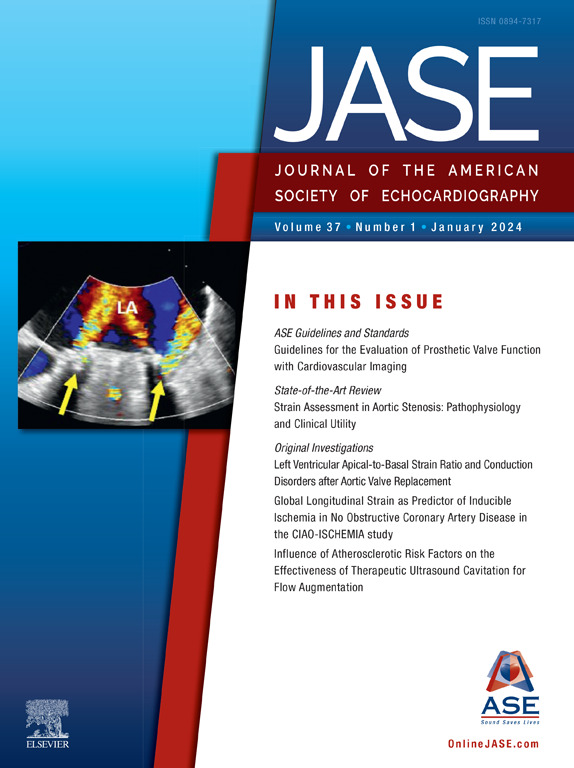Normal Values of Echocardiographic Left Atrioventricular Coupling Index and Left Atrial Stiffness Index Reflecting Left Ventricular Diastolic Function: A Multicenter Study
IF 6
2区 医学
Q1 CARDIAC & CARDIOVASCULAR SYSTEMS
Journal of the American Society of Echocardiography
Pub Date : 2025-09-01
DOI:10.1016/j.echo.2025.04.011
引用次数: 0
Abstract
Background
The left atrioventricular coupling index (LACI) and left atrial stiffness index (LASI) have recently demonstrated significant correlations with left ventricular (LV) diastolic function. However, the absence of reference values limits their widespread use. This study aimed to establish normal reference ranges for LACI and LASI.
Methods
A total of 1,648 healthy participants from 55 centers were enrolled. The LACI was defined as the ratio of left atrial (LA) minimum volume to LV end-diastolic volume. The LASI was calculated as the ratio of the average E/e' ratio to LA reservoir strain.
Results
Both LACI and LASI increased with age in both sexes. The LACI was higher in women than in men (P < .001), whereas no significant sex difference was observed for LASI (P = .868). Age, sex, LV global longitudinal strain (GLS), and LA reservoir strain independently predicted LACI. Age, body mass index, LV GLS, and LA volume index were independently associated with LASI. Elevated LACI and LASI were observed in participants with high-normal blood pressure, overweight status, and indeterminate LV diastolic function.
Conclusions
Sex- and age-stratified reference values for LACI and LASI were established. Left ventricular GLS, LA reservoir strain, and LA volume index should be considered when interpreting these parameters. Hypertension, obesity, and LV diastolic dysfunction may significantly affect LACI and LASI, suggesting their potential utility in identifying early cardiac dysfunction.
反映左室舒张功能的超声心动图左房室耦合指数和左房刚度指数的正常值:一项多中心研究。
背景:左房室耦合指数(LACI)和左房刚度指数(LASI)最近被证明与左室舒张功能有显著相关性。然而,缺乏参考值限制了它们的广泛使用。本研究旨在建立LACI和LASI的正常参考范围。方法:来自55个中心的1648名健康参与者被纳入研究。LACI定义为左房(LA)最小容积与左室舒张末期容积之比。LASI计算为平均E/ E′比与LA储层应变之比。结果:男女LACI和LASI均随年龄增长而增加。女性LACI高于男性(P < 0.001),而LASI的性别差异无统计学意义(P = 0.868)。年龄、性别、LV全球纵向应变(GLS)和LA库应变独立预测LACI。年龄、体重指数、左室GLS和左室容积指数与LASI独立相关。在正常血压高、超重和左室舒张功能不确定的参与者中观察到LACI和LASI升高。结论:建立了LACI和LASI的性别和年龄分层参考值。在解释这些参数时应考虑LV GLS、LA储层应变和LA体积指数。高血压、肥胖和左室舒张功能障碍可能显著影响LACI和LASI,提示它们在识别早期心功能障碍方面的潜在用途。
本文章由计算机程序翻译,如有差异,请以英文原文为准。
求助全文
约1分钟内获得全文
求助全文
来源期刊
CiteScore
9.50
自引率
12.30%
发文量
257
审稿时长
66 days
期刊介绍:
The Journal of the American Society of Echocardiography(JASE) brings physicians and sonographers peer-reviewed original investigations and state-of-the-art review articles that cover conventional clinical applications of cardiovascular ultrasound, as well as newer techniques with emerging clinical applications. These include three-dimensional echocardiography, strain and strain rate methods for evaluating cardiac mechanics and interventional applications.

 求助内容:
求助内容: 应助结果提醒方式:
应助结果提醒方式:


